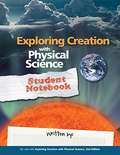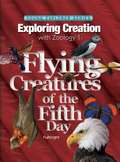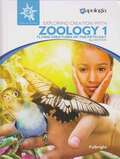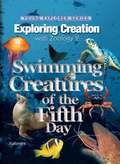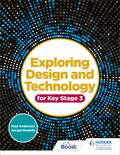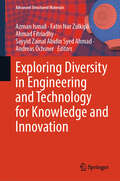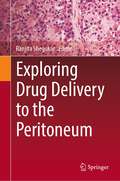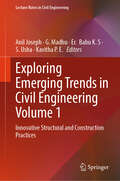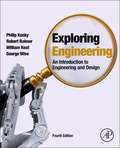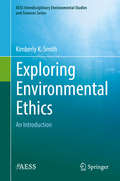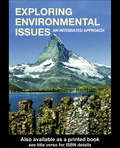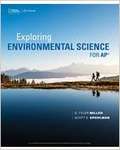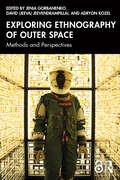- Table View
- List View
Exploring Creation with Physical Science Student Notebook
by Vicki DincherThis is a great way to help your junior high students develop the independent study skills they'll need as they prepare to make the transition to high school. This companion notebook designed to be used with Exploring Creation with Physical Science, 2nd Edition will deepen their understanding of the textbook as they explore what God's Word has to say about the workings of His creation. Includes bonus material from Debra Bell's Study Smart Student Toolkit.
Exploring Creation with Physical Science: Student Text (Second Edition)
by Jay L. WileLearn more about science and the natural world from a Christian perspective.
Exploring Creation with Zoology 1: Flying Creatures of the Fifth Day
by Jay L. Wile Jeannie FulbrightYou will find this book to be an easy to use science curriculum for your whole family. The text is written directly to the student, making it very appealing to kids from six to thirteen. The material is presented in a conversational, engaging style that will make science enchanting and memorable for your students, creating an environment in which learning is a joy.
Exploring Creation with Zoology 1: Flying Creatures of the Fifth Day
by Jeannie K. FulbrightExploring Creation with Zoology 1: Flying Creatures of the Fifth Day, 2nd Edition is part of Apologia’s award-winning Young Explorer Series designed for elementary students. Throughout this homeschool science curriculum, students will learn about the amazing design and characteristics of flying creatures as part of God’s creation. They’ll also be empowered to apply their newfound knowledge as they observe the wonder of flight in their own backyards!
Exploring Creation with Zoology 2: Swimming Creatures of the Fifth Day
by Jeannie K. FulbrightExploring Creation with Zoology 2: Swimming Creatures of the Fifth Day will take you on a journey through the oceans and streams of the world to discover many of the charming, exotic, fascinating, and fanciful creatures God created on the fifth day.
Exploring Dark Comedy in Ecological Literature: Echoes of Laughter in the Capitalocene
by Nagendra Kumar Tanu Gupta Mohammad RahmatullahIn this textbook, &‘dark comedy&’ is re-imagined as an ecological instrument: a volatile compound of irony, grotesquerie, and mischievous insight that exposes the carbonised scaffolding of late-capitalist life. Rather than sneering at catastrophe, the chapters anatomise the mechanics—defamiliarising punch line, carnival inversion, affective whiplash—by which humour slips past guard-dogs and rouses an anaesthetised public. The horizon against which this inquiry unfolds is the Capitalocene: a name that indicts capitalism, not &“Man,&” as the principal geological agent of ruin. Moving from Aristophanes to Atwood, from street theatre to streaming satire, each text shows laughter doing intellectual lifting. In one moment it fractures complacent common sense; in the next it stitches together circuits of feeling in which eco-grief can transmute into civic resolve. Juxtaposed with the authority of tragic form, dark comedy proves the more permeable solvent: it dissolves cultural defences, lets paradox breathe, and leaves readers wondering how ecosystems became punch-lines. Methodologically the book is multidisciplinary. Literary tangles with environmental philosophy; humour theory quarrels with eco-Marxism; cultural studies supplies the ethnographic grit that keeps abstraction honest. By braiding those strands the argument departs from standard ecocritical curricula, insisting that jokes are not side-shows but catalytic sites where ethics, affect, and political economy collide. Designed for advanced undergraduates yet hospitable to researchers, the volume refuses the consolations of easy optimism even as it gestures toward actionable hope. Its wager is simple: teach readers to hear the subversive crackle inside dark laughter and they may also learn to re-script the damaged world that provokes it.
Exploring Design and Technology for Key Stage 3
by Paul Anderson Jacqui HowellsDevelop knowledge, understanding and designing and making skills through Key Stage 3 so students are ready for the new GCSE in Design and Technology, with our brand-new Student Book.With topics directly linked to the new GCSE (9-1) specifications, Exploring Design and Technology will build a solid foundation by boosting your students' understanding of the key concepts, introducing them to important terminology and developing their practical skills through Key Stage 3.· Build understanding through years 7, 8 and 9 with engaging, carefully timed and level-appropriate lessons that draw on the GCSE subject content.· Develop practical skills with a variety of creative designing and making activities that use a wide range of materials, tools, equipment and processes. · Boost knowledge with clear explanations of important terminology and concepts that students will need to apply when identifying design problems, understanding user needs and developing design solutions in a range of contexts.· Encourage subject interest with 'find out more' - research features that broaden understanding of materials and their working properties, new technologies and the wider influences on designing and making.· Monitor and measure student progress with knowledge check questions provided for every topic.
Exploring Design and Technology for Key Stage 3
by Paul Anderson Jacqui HowellsDevelop knowledge, understanding and designing and making skills through Key Stage 3 so students are ready for the new GCSE in Design and Technology, with our brand-new Student Book.With topics directly linked to the new GCSE (9-1) specifications, Exploring Design and Technology will build a solid foundation by boosting your students' understanding of the key concepts, introducing them to important terminology and developing their practical skills through Key Stage 3.· Build understanding through years 7, 8 and 9 with engaging, carefully timed and level-appropriate lessons that draw on the GCSE subject content.· Develop practical skills with a variety of creative designing and making activities that use a wide range of materials, tools, equipment and processes. · Boost knowledge with clear explanations of important terminology and concepts that students will need to apply when identifying design problems, understanding user needs and developing design solutions in a range of contexts.· Encourage subject interest with 'find out more' - research features that broaden understanding of materials and their working properties, new technologies and the wider influences on designing and making.· Monitor and measure student progress with knowledge check questions provided for every topic.
Exploring Diversity in Engineering and Technology for Knowledge and Innovation (Advanced Structured Materials #215)
by Andreas Öchsner Azman Ismail Fatin Nur Zulkipli Ahmad Fitriadhy Sayyid Zainal Abidin Syed AhmadThis book offers research result which covers a wide range of topics, including sediment transportation in rivers, efficient adsorption processes, renewable energy, structural resilience, and environmental studies. Researchers explore various areas, including the stability of fishing vessels, the impact of mining on riverbeds, traditional navigation methods, medical procedures, advanced materials, and the utilization of artificial intelligence in data analysis. These comprehensive papers also address structural analysis, chloride-induced damage assessment, and the potential of soy biodiesel in marine engines. It concludes with discussions on probabilistic models, sustainable aquaculture, planning for renewable energy, and the integration of technology in environmental monitoring. This diverse compilation underscores the unwavering pursuit of knowledge and innovation across scientific and engineering disciplines, offering promise for a brighter and more technologically advanced future.
Exploring Drug Delivery to the Peritoneum
by Ranjita ShegokarThe Peritoneal cavity (PC) is the key metastatic site for intra-abdominal malignancies (e.g., GI tract and rectal cancer). PC sites can be used to target several other diseases where lymphatic drug delivery is desired without dumping large amounts of the drug. Till recently, it was thought that treatment with curative intent was impossible but that was challenged by the introduction of cytoreductive surgery (CRS) and heated intraperitoneal chemotherapy (HIPEC), and PIPAC (pressurized intraperitoneal aerosol chemotherapy). Recently, a growing number of preclinical and clinical studies advocate intraperitoneal (IP) chemotherapy as an alternative post-operative therapy for cancer. Although their effectiveness has been proven both experimentally and clinically, there is still little understanding of the role of drug delivery systems (DDS) in targeting drugs in the intraperitoneal (IP) cavity.There are two main challenges one posed by IP cavity where the residence time of a small molecular weight drug (In summary, challenges like delivery to IP cavity, tumor or organ-specific targeting, efficient tissue penetration, optimal cellular uptake and intracellular residence of a drug, biocompatibility, toxicity, etc can be easily solved by smartly designing functional drug delivery systems (both nano and micro). Nanotechnologies have always fascinated humans for several decades and are now widely explored in the biomedical field. Diverse types of nanoparticles are being explored around the world, some examples include biodegradable nanoparticles, green nanoparticles, polymeric nanoparticles, lipid nanoparticles, metal nanoparticles, graphene, carbon nanotubes, and several others. Now a day's nanoparticles are gaining interest for drug targeting of chemotherapeutic drugs, immunotherapy, and gene delivery. Whereas microparticles can be explored for delayed drug delivery to the peritoneal cavity due to relatively slow removal from IP fluid. Hydrogels or other adhesive drug delivery may help to enhance peritoneal adhesions; thereby maintaining the balance between benefit and risk. Overall, drug delivery systems are key in IP targeting. That means drug delivery specialist and clinician needs to be connected to get the best out of this route of drug administration.The present book is a link between pharmaceutical scientists (drug formulators), clinicians, toxicologists, and regulatory experts. This book also provides a new perspective to researchers to divert or guide their research in an optimal way. Exploring Drug Delivery to the Peritoneum serves as a platform for upcoming technologies especially in the medical devices sector to face up and show potential in delivering drugs. It is a chance for commercial partners like insurance companies and the pharma industry to explore this direction.
Exploring Education and Democratization in South Asia: Research, Policy, and Practice (South Asian Education Policy, Research, and Practice)
by Tania Saeed Radhika Iyengar Matthew A. Witenstein Erik Jon BykerThis volume brings together scholars, practitioners, activists, and students to reflect on socio-political transitions taking place in countries across South Asia and their implications for democracy and education. It provides an important intervention for comparative education in South Asia by looking at the kind of ideological tensions that exist within the education systems, and how these competing agendas are visible at different levels. At a time when students have been protesting for their rights across educational institutions in South Asia, where the Covid-19 pandemic has exacerbated inequalities with learning losses, and job losses, this collection creates a space to reflect on the limitations and possibilities of education in democracies across South Asia.
Exploring Electron–Neutrino–Argon Interactions (Springer Theses)
by Krishan V. MistryThis thesis explores the electron-neutrino and antineutrino cross section on argon using the MicroBooNE liquid argon time projection chamber detector.With only a handful of electron neutrino cross section measurements in the hundred MeV to GeV range to date and only one of them on argon as the target nucleus: the result from the ArgoNeuT experiment, there is a need for new, large statistics, electron-neutrino cross section measurements. The precise knowledge of the electron neutrino cross section is fundamental for tests of lepton universality, making meaningful interpretations of neutrino oscillations and beyond the Standard Model search experiments involving electron neutrinos. Moreover, the appearance of electron neutrinos in a beam of predominantly muon neutrinos is the key signature in searches for sterile neutrinos in short-baseline experiments and measurements of Charge-Parity violation in long-baseline oscillation experiments.The measurements in this thesis utilize the NuMI neutrino beamline which is highly off-axis to the MicroBooNE detector but provides a rich source of electron-neutrinos. Critical to the measurement of the cross section is a detailed understanding of the flux of neutrinos at MicroBooNE and the uncertainties associated with it. The neutrino flux prediction tools used for the on-axis NuMI experiments are described and studied in detail for their implementation in the case of MicroBooNE. These tools will form the foundation for many future measurements using the NuMI beam at MicroBooNE.With the use of argon as a target for studying neutrino interactions, the large size of the nucleus introduces nuclear effects which impact the kinematics and multiplicities of the particles produced in the initial interaction. Such effects are complicated to model and are currently an active area of research with various models and neutrino generators available. The measurements in this thesis compare the electron-neutrino argon cross section to several neutrino generators with differing physics models. These comparisons provide important information in the modelling of neutrino interactions with nuclei such as argon.The target audience for this thesis is aimed at particle physics graduate students, particularly in the field of neutrino physics working with noble element time-projection chambers.
Exploring Elementary Science Teaching and Learning in Canada (Contemporary Trends and Issues in Science Education #53)
by Christine D. Tippett Todd M. MilfordThis edited volume showcases current science education research in Canada, from pre-Kindergarten to Grade 7, conducted in Canada by a diverse group of researchers from across the country. We draw on the themes that emerged from our previous book, Science Education in Canada: Consistencies, Commonalities, and Distinctions, to guide the structure of this book on elementary science education research. In particular, chapters on science teacher preparation; Indigenous perspectives; environmental education; science, technology, engineering, and mathematics (STEM); and science, technology, society, and the environment (STSE) reflect a Canadian perspective. However, these themes are of global interest and authors include ideas for how science education research in Canada might be used by academics and researchers in other countries. This book builds a cohesive picture of current elementary science education research in Canada, highlighting themes that will resonate with international readers.
Exploring Emerging Trends in Civil Engineering Volume 1: Innovative Structural and Construction Practices (Lecture Notes in Civil Engineering #737)
by Anil Joseph G. Madhu Er. Babu K. S S. Usha Kavitha P. E.This national convention on engineering topics will explore the dynamic shifts and emerging trends that are reshaping civil engineering,emphasizing their vital role in developing safer, more efficient, and sustainable infrastructure. Our focus willspan several transformative innovations, beginning with the integration of 3D printing and robotics inconstruction. These technologies are revolutionizing the field by enhancing productivity, slashing labor costs,and improving safety through automated processes and the ability to produce complex structures. Theconvention will also highlight the increasing importance of resilience in our infrastructure, a response to themore frequent natural disasters driven by climate change. Today&’s civil engineers integrate considerations ofthese changes in their designs to construct buildings and structures that withstand and adapt to theseevolving conditions. Sustainability remains a crucial theme, driven by the urgent need for environmentalconservation and the realities of climate change. Our discussions will delve into green engineering practices,such as the use of eco-friendly materials, waste minimization, and the design of energy-efficient buildings.Innovations like Geopolymer technology offer rapid strength gain and reduced water use, presenting asustainable alternative to traditional concrete. Similarly, Bacterial Concrete represents a breakthrough inenhancing the durability and reducing the maintenance costs of concrete structures while lowering carbonemissions. The convention will also examine the role of advanced technologies like Cartography, remotesensing, and GIS applications, which are transforming our understanding and representation of the world,pushing the boundaries of traditional cartography into new digital frontiers. Additionally, modular constructionwill be discussed as a key contributor to efficiency, waste reduction, and quality in building processes,especially in its potential to address the critical needs for affordable housing and sustainable urban development. Furthermore, the financial benefits of retrofitting, which reduces energy consumption and offerssignificant cost savings, will be explored, showcasing its attractiveness and positive return on investmentover time. This convention is not just an event, but a call to action for civil engineering professionals toembrace these innovations, stay informed of cutting-edge developments, and play a pivotal role in crafting asafer, more efficient, and sustainable built environment. Join us as we leverage these trends to propel theindustry forward, ensuring our built environment can meet the demands of tomorrow.
Exploring Emotions, Aesthetics and Wellbeing in Science Education Research
by Kathrin Otrel-Cass Alberto Bellocchi Cassie QuigleyThis book addresses new research directions focusing on the emotional and aesthetic nature of teaching and learning science informing more general insights about wellbeing. It considers methodological traditions including those informed by philosophy, sociology, psychology and education and how they contribute to our understanding of science education. In this collection, the authors provide accounts of the underlying ontological, epistemological, methodological perspectives and theoretical assumptions that inform their work and that of others. Each chapter provides a perspective on the study of emotion, aesthetics or wellbeing, using empirical examples or a discussion of existing literature to unpack the theoretical and philosophical traditions inherent in those works. This volume offers a diverse range of approaches for anyone interested in researching emotions, aesthetics, or wellbeing. It is ideal for research students who are confronted with a cosmos of research perspectives, but also for established researchers in various disciplines with an interest in researching emotions, affect, aesthetics, or wellbeing.
Exploring Engineering: An Introduction to Engineering and Design
by George Wise Philip Kosky Robert Balmer William KeatThe book presents the emerging challenges engineers face in a wide range of areas as they work to help improve our quality of life. In this textbook, the authors explain what engineers actually do, from the fundamental principles that form the basis of their work to the application of that knowledge within a structured design process. The text itself is organized into three parts: Lead On, Minds On, Hands On. This organization allows the authors to give a basic introduction to engineering methods, then show the application of these principles and methods, and finally present a design challenge. This book is an ideal introduction for anyone interested in exploring the various fields of engineering and learning how engineers work to solve problems.
Exploring Environmental Change Using an Integrative Method
by Mark LemonThis text draws upon 'complex systems' thinking to introduce a policy-related integrative method for diagnosing and managing environmental change. This conveys how existing intellectual resources can be exploited to explore environmental decision issues without resoring to such devices as 'meta-methods' or 'meta-disciplines'.
Exploring Environmental Ethics: An Introduction (Aess Interdisciplinary Environmental Studies And Sciences Ser.)
by Kimberly K. SmithThis book is designed as a basic text for courses that are part of an interdisciplinary program in environmental studies. The intended reader is anyone who expects environmental stewardship to be an important part of his or her life, as a citizen, a policy maker, or an environmental management professional. In addition to discussing major issues in environmental ethics, it invites readers to think about how an ethicist's perspective differs from the perspectives encountered in other environmental studies courses. Additional topics covered include corporate social responsibility, ecological citizenship, property theory, and the concept of stewardship as a vocation.
Exploring Environmental Issues: An Integrated Approach
by David D. KempGlobal warming, ozone depletion, drought, acid rain - their causes are viewed as extraordinarily complex; their effects are assumed catastrophic. Exploring Environmental Issues provides a key to understanding our potential crisis. The concise, introductory text presents a review of current environmental issues using a geographical approach that stresses the interrelationships between environment and societies.This user-friendly volume is an essential book for students and all who are concerned with the nature of contemporary environmental issues. Information is presented in a refreshing manner utilising over 170 figures and 50 photographs. Global boxed case studies are used throughout to highlight and explore issues in more detail. The text also contains discussion points, annotated further reading and an extensive glossary.
Exploring Environmental Science for AP®
by Scott Spoolman G. MillerNIMAC-sourced textbook <P><P>Written specifically for the AP Environmental Science course, authors Tyler Miller and Scott Spoolman connect the themes of economics, politics, ethics, policy, and sustainability together for an engaging and thorough presentation of environmental science concepts. Features to assist students in preparing for the AP exam for Environmental Science include Multiple Choice and Free-Response review questions at the end of each chapter and unit, and a full AP Practice Test at the end of the book.
Exploring Ethnography of Outer Space: Methods and Perspectives (Anthropology of Now)
by David Jeevendrampillai Jenia Gorbanenko Adryon KozelThis book explores new methods and perspectives in the anthropology of outer space. For the past ten years, scholarship of outer space has grown significantly in the social sciences. Now, an international community of anthropologists is starting to produce significant contributions to this work. This is pushing the conversations around the future of humanity, technology, and outer space beyond the realm of speculative theory into concrete challenges to established norms within anthropology. Each chapter in this volume introduces a unique take on what constitutes an ethnographic field in anthropology. They signal a re-imagination of the central concept for the discipline and offer a timely meditation on the shift in anthropology’s understanding of fieldwork from its inception until now. The volume consists of eleven ethnographic chapters, plus an introduction by the editors, and two invited responses. Each of the main body chapters presents a distinct approach to situating outer space empirically on Earth. By bringing together emerging and established scholars, this book ultimately posits that an anthropological approach to outer space requires creative approaches to ethnography that are no longer exclusively premised on a co-presence with the people under study. A primer of innovative ethnographies and an ideal companion to courses on methods, this volume will provide students with a body of accessible, contemporary work on futurisms and outer space. In addition, this book will serve as a snapshot of a moment in ethnographically innovative anthropology that will be relevant to a wider academic audience through its exegesis of new methods for the study of distributed communities.
Exploring Flight! (Questioneers)
by David Roberts Andrea Beaty Theanne GriffithFrom the New York Times bestselling creator of the Questioneers, Andrea Beaty, and author Theanne Griffith, Exploring Flight! (Ada Twist, Scientist: The Why Files) is the first in a full-color nonfiction early-reader series based on the Netflix series! <P><P> Why do airplanes look the way they do? Why can’t birds fly when they’re first born? And why do some paper planes fly farther than others? Ada Twist, Scientist: The Why Files is the perfect nonfiction resource for all these questions and more. Discover everything there is to know about flight from Ada Twist, Scientist—from information about creatures that fly, to the history of aircrafts, to modern technology that allows us to soar through the air faster than ever! Based on the bestselling series and the Netflix show, this nonfiction series is perfect for the youngest scientists of tomorrow!
Exploring Food and Nutrition for Key Stage 3
by Yvonne Mackey Bev SaunderCombine the essential ingredients that will develop knowledge, understanding and cooking skills through Key Stage 3, so students are ready for the new GCSE in Food Preparation and Nutrition. With topics linked directly to the new GCSE specifications, Exploring Food and Nutrition helps you to build knowledge and understanding of key concepts and introduce important terminology as your students progress through Key Stage 3, providing a solid foundation for the Food Preparation and Nutrition GCSE.- Develop topic understanding through Key Stage 3, drawing on subject content at GCSE, with engaging, carefully timed and level-appropriate lessons- Build food preparation and cooking skills required at GCSE with 'Skills focus': from basic skills at Year 7 through to more advanced techniques in Year 9- Encourage subject interest with suggested activities and 'Find out more' research features for each topic, that are appropriate for your students in years 7, 8 and 9- Ensure nutritional understanding with clear explanation of the up-to-date terminology, data and concepts that students will need to know in order to apply the principles of healthy eating - Monitor and measure student progress with knowledge check questions provided for every topic
Exploring Food and Nutrition for Key Stage 3
by Yvonne Mackey Bev SaunderCombine the essential ingredients that will develop knowledge, understanding and cooking skills through Key Stage 3, so students are ready for the new GCSE in Food Preparation and Nutrition. With topics linked directly to the new GCSE specifications, Exploring Food and Nutrition helps you to build knowledge and understanding of key concepts and introduce important terminology as your students progress through Key Stage 3, providing a solid foundation for the Food Preparation and Nutrition GCSE.- Develop topic understanding through Key Stage 3, drawing on subject content at GCSE, with engaging, carefully timed and level-appropriate lessons- Build food preparation and cooking skills required at GCSE with 'Skills focus': from basic skills at Year 7 through to more advanced techniques in Year 9- Encourage subject interest with suggested activities and 'Find out more' research features for each topic, that are appropriate for your students in years 7, 8 and 9- Ensure nutritional understanding with clear explanation of the up-to-date terminology, data and concepts that students will need to know in order to apply the principles of healthy eating - Monitor and measure student progress with knowledge check questions provided for every topic
Exploring Frontiers of the Mind-Brain Relationship
by Alexander Moreira-Almeida Franklin Santana SantosThe conscious mind defines human existence. Many consider the brain as a computer, and they attempt to explain consciousness as emerging at a critical, but unspecified, threshold level of complex computation among neurons. The brain-as-computer model, however, fails to account for phenomenal experience and portrays consciousness as an impotent, after-the-fact epiphenomenon lacking causal power. And the brain-as-computer concept precludes even the remotest possibility of spirituality. As described throughout the history of humankind, seemingly spiritual mental phenomena including transcendent states, near-death and out-of-body experiences, and past-life memories have in recent years been well documented and treated scientifically. In addition, the brain-as-computer approach has been challenged by advocates of quantum brain biology, who are possibly able to explain, scientifically, nonlocal, seemingly spiritual mental states. Exploring Frontiers of the Mind-Brain Relationship argues against the purely physical analysis of consciousness and for a balanced psychobiological approach. This thought-provoking volume bridges philosophy of mind with science of mind to look empirically at transcendent phenomena, such as mystic states, near-death experiences and past-life memories, that have confounded scientists for decades. Representing disciplines ranging from philosophy and history to neuroimaging and physics, and boasting a panel of expert scientists and physicians, including Andrew Newberg, Peter Fenwick, Stuart Hameroff, Mario Beauregard, Deepak Chopra, and Chris Clarke the book rigorously follows several lines of inquiry into mind-brain controversies, challenging readers to form their own conclusions--or reconsider previous ones. Key coverage includes: Objections to reductionistic materialism from the philosophical and the scientific tradition.Phenomena and the mind-brain problem.The neurobiological correlates of meditation and mindfulness.The quantum soul, a view from physics.Clinical implications of end-of-life experiences.Mediumistic experience and the mind-brain relationship. Exploring Frontiers of the Mind-Brain Relationship is essential reading for researchers and clinicians across many disciplines, including cognitive psychology, personality and social psychology, the neurosciences, neuropsychiatry, palliative care, philosophy, and quantum physics. "This book ... brings together some precious observations about the fundamental mystery of the nature of consciousness ... It raises many questions that serve to invite each of us to be more aware of the uncertainty of our preconceptions about consciousness ... This book on the frontiers of mind-body relationships is a scholarly embodiment of creative and open-minded science." C. Robert Cloninger, MD Wallace Renard Professor of Psychiatry, Genetics, and Psychology, Washington University School of Medicine St. Louis MO
